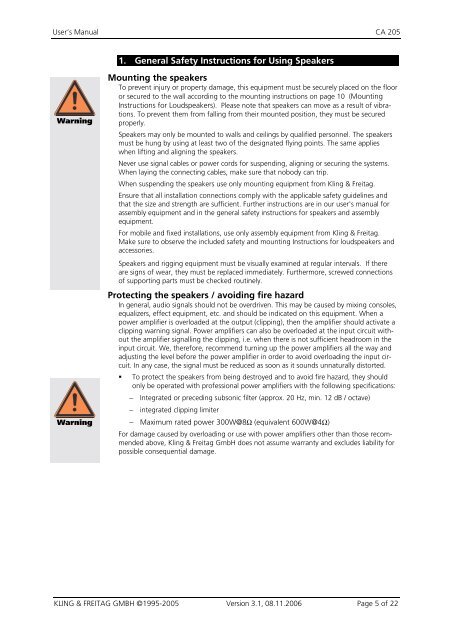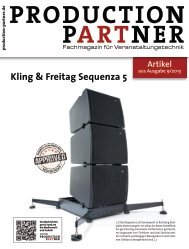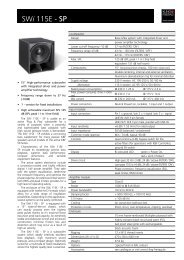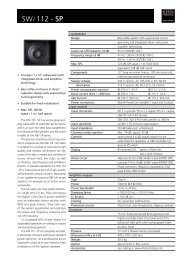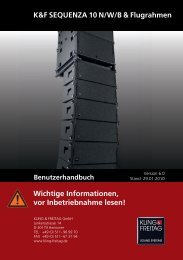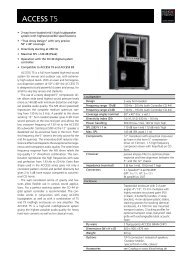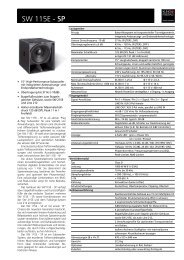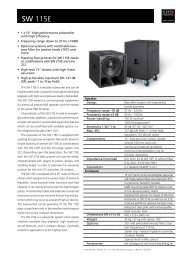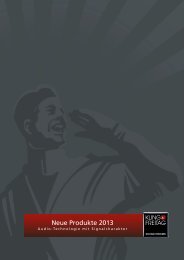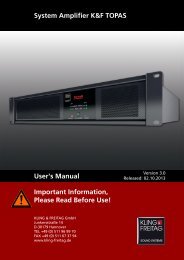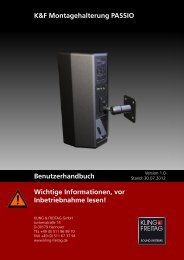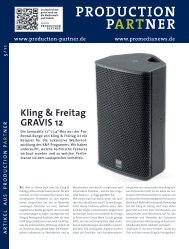User's Manual - Kling & Freitag
User's Manual - Kling & Freitag
User's Manual - Kling & Freitag
You also want an ePaper? Increase the reach of your titles
YUMPU automatically turns print PDFs into web optimized ePapers that Google loves.
User’s <strong>Manual</strong> CA 205<br />
1. General Safety Instructions for Using Speakers<br />
Warning<br />
Warning<br />
Mounting the speakers<br />
To prevent injury or property damage, this equipment must be securely placed on the floor<br />
or secured to the wall according to the mounting instructions on page 10 (Mounting<br />
Instructions for Loudspeakers). Please note that speakers can move as a result of vibrations.<br />
To prevent them from falling from their mounted position, they must be secured<br />
properly.<br />
Speakers may only be mounted to walls and ceilings by qualified personnel. The speakers<br />
must be hung by using at least two of the designated flying points. The same applies<br />
when lifting and aligning the speakers.<br />
Never use signal cables or power cords for suspending, aligning or securing the systems.<br />
When laying the connecting cables, make sure that nobody can trip.<br />
When suspending the speakers use only mounting equipment from <strong>Kling</strong> & <strong>Freitag</strong>.<br />
Ensure that all installation connections comply with the applicable safety guidelines and<br />
that the size and strength are sufficient. Further instructions are in our user's manual for<br />
assembly equipment and in the general safety instructions for speakers and assembly<br />
equipment.<br />
For mobile and fixed installations, use only assembly equipment from <strong>Kling</strong> & <strong>Freitag</strong>.<br />
Make sure to observe the included safety and mounting Instructions for loudspeakers and<br />
accessories.<br />
Speakers and rigging equipment must be visually examined at regular intervals. If there<br />
are signs of wear, they must be replaced immediately. Furthermore, screwed connections<br />
of supporting parts must be checked routinely.<br />
Protecting the speakers / avoiding fire hazard<br />
In general, audio signals should not be overdriven. This may be caused by mixing consoles,<br />
equalizers, effect equipment, etc. and should be indicated on this equipment. When a<br />
power amplifier is overloaded at the output (clipping), then the amplifier should activate a<br />
clipping warning signal. Power amplifiers can also be overloaded at the input circuit without<br />
the amplifier signalling the clipping, i.e. when there is not sufficient headroom in the<br />
input circuit. We, therefore, recommend turning up the power amplifiers all the way and<br />
adjusting the level before the power amplifier in order to avoid overloading the input circuit.<br />
In any case, the signal must be reduced as soon as it sounds unnaturally distorted.<br />
• To protect the speakers from being destroyed and to avoid fire hazard, they should<br />
only be operated with professional power amplifiers with the following specifications:<br />
− Integrated or preceding subsonic filter (approx. 20 Hz, min. 12 dB / octave)<br />
− integrated clipping limiter<br />
− Maximum rated power 300W@8Ω (equivalent 600W@4Ω)<br />
For damage caused by overloading or use with power amplifiers other than those recommended<br />
above, <strong>Kling</strong> & <strong>Freitag</strong> GmbH does not assume warranty and excludes liability for<br />
possible consequential damage.<br />
KLING & FREITAG GMBH ©1995-2005 Version 3.1, 08.11.2006 Page 5 of 22


